Methodological Rigor: Appraising Qualitative Evidence in Medical ICU
VerifiedAdded on 2023/06/05
|5
|1039
|478
Essay
AI Summary
This essay provides an appraisal of methodological rigor in qualitative evidence within a medical ICU setting. It discusses criteria for appraising qualitative evidence, including purpose, literature review, study design, theoretical perspective, and analytical rigor. The essay compares qualitative and quantitative research methods, highlighting differences in data collection and analysis techniques such as document analysis, focus groups, interviews, and observational studies. It addresses potential issues in evaluating qualitative studies, such as erroneous data interpretation due to patient conditions. The study concludes by emphasizing the importance of qualitative evidence in informing future healthcare decisions and highlighting the need for proper appraisal methods in both qualitative and quantitative research. Desklib provides access to similar solved assignments and study resources for students.
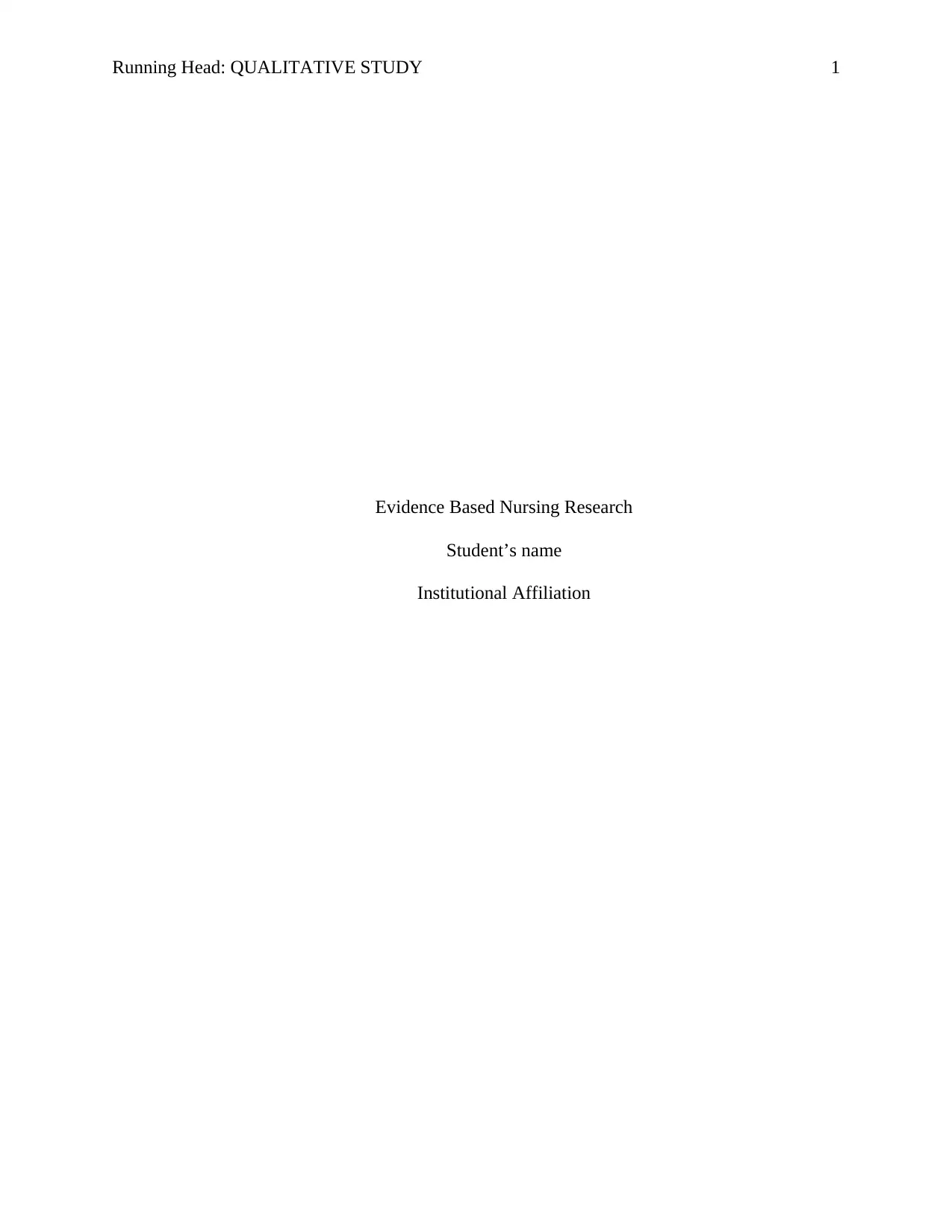
Running Head: QUALITATIVE STUDY 1
Evidence Based Nursing Research
Student’s name
Institutional Affiliation
Evidence Based Nursing Research
Student’s name
Institutional Affiliation
Paraphrase This Document
Need a fresh take? Get an instant paraphrase of this document with our AI Paraphraser
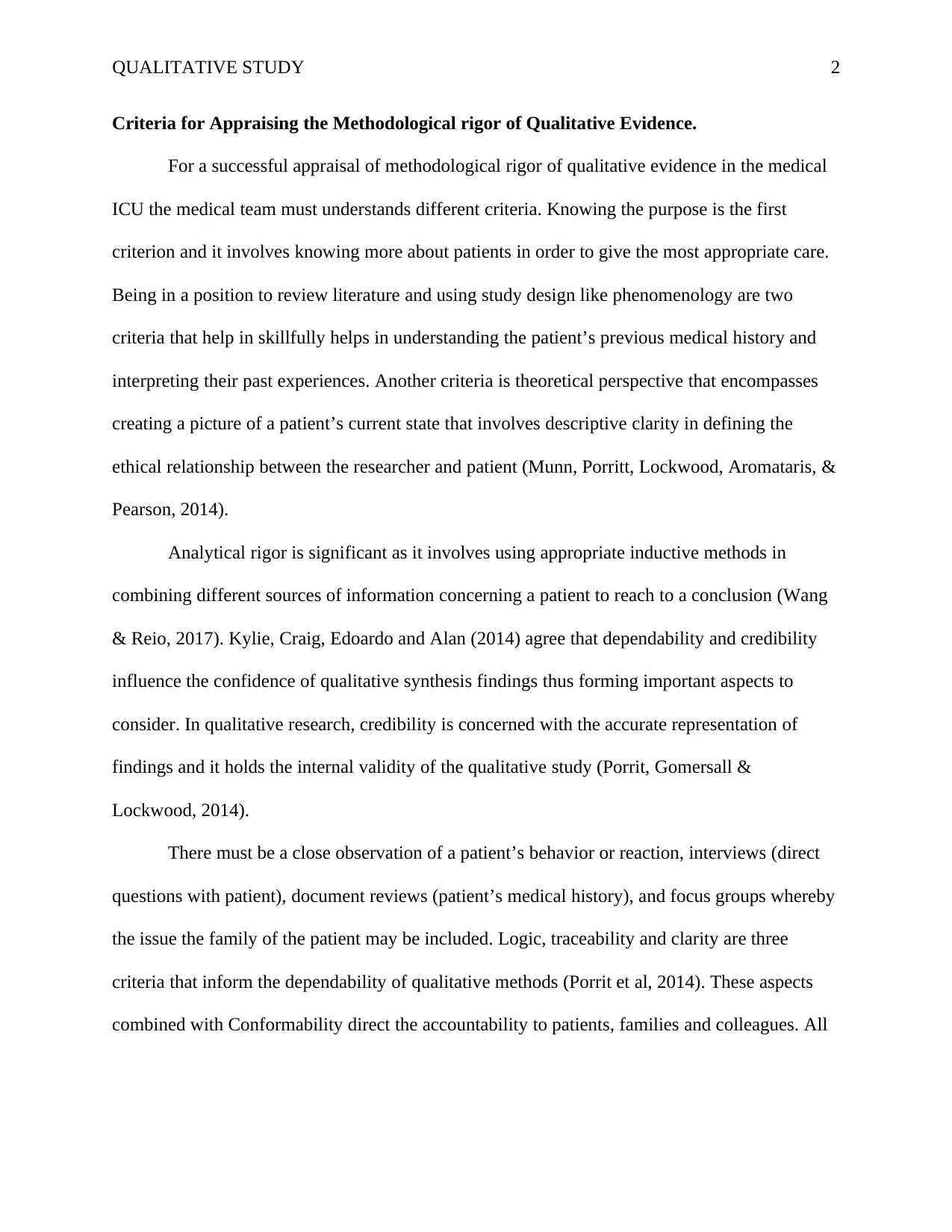
QUALITATIVE STUDY 2
Criteria for Appraising the Methodological rigor of Qualitative Evidence.
For a successful appraisal of methodological rigor of qualitative evidence in the medical
ICU the medical team must understands different criteria. Knowing the purpose is the first
criterion and it involves knowing more about patients in order to give the most appropriate care.
Being in a position to review literature and using study design like phenomenology are two
criteria that help in skillfully helps in understanding the patient’s previous medical history and
interpreting their past experiences. Another criteria is theoretical perspective that encompasses
creating a picture of a patient’s current state that involves descriptive clarity in defining the
ethical relationship between the researcher and patient (Munn, Porritt, Lockwood, Aromataris, &
Pearson, 2014).
Analytical rigor is significant as it involves using appropriate inductive methods in
combining different sources of information concerning a patient to reach to a conclusion (Wang
& Reio, 2017). Kylie, Craig, Edoardo and Alan (2014) agree that dependability and credibility
influence the confidence of qualitative synthesis findings thus forming important aspects to
consider. In qualitative research, credibility is concerned with the accurate representation of
findings and it holds the internal validity of the qualitative study (Porrit, Gomersall &
Lockwood, 2014).
There must be a close observation of a patient’s behavior or reaction, interviews (direct
questions with patient), document reviews (patient’s medical history), and focus groups whereby
the issue the family of the patient may be included. Logic, traceability and clarity are three
criteria that inform the dependability of qualitative methods (Porrit et al, 2014). These aspects
combined with Conformability direct the accountability to patients, families and colleagues. All
Criteria for Appraising the Methodological rigor of Qualitative Evidence.
For a successful appraisal of methodological rigor of qualitative evidence in the medical
ICU the medical team must understands different criteria. Knowing the purpose is the first
criterion and it involves knowing more about patients in order to give the most appropriate care.
Being in a position to review literature and using study design like phenomenology are two
criteria that help in skillfully helps in understanding the patient’s previous medical history and
interpreting their past experiences. Another criteria is theoretical perspective that encompasses
creating a picture of a patient’s current state that involves descriptive clarity in defining the
ethical relationship between the researcher and patient (Munn, Porritt, Lockwood, Aromataris, &
Pearson, 2014).
Analytical rigor is significant as it involves using appropriate inductive methods in
combining different sources of information concerning a patient to reach to a conclusion (Wang
& Reio, 2017). Kylie, Craig, Edoardo and Alan (2014) agree that dependability and credibility
influence the confidence of qualitative synthesis findings thus forming important aspects to
consider. In qualitative research, credibility is concerned with the accurate representation of
findings and it holds the internal validity of the qualitative study (Porrit, Gomersall &
Lockwood, 2014).
There must be a close observation of a patient’s behavior or reaction, interviews (direct
questions with patient), document reviews (patient’s medical history), and focus groups whereby
the issue the family of the patient may be included. Logic, traceability and clarity are three
criteria that inform the dependability of qualitative methods (Porrit et al, 2014). These aspects
combined with Conformability direct the accountability to patients, families and colleagues. All
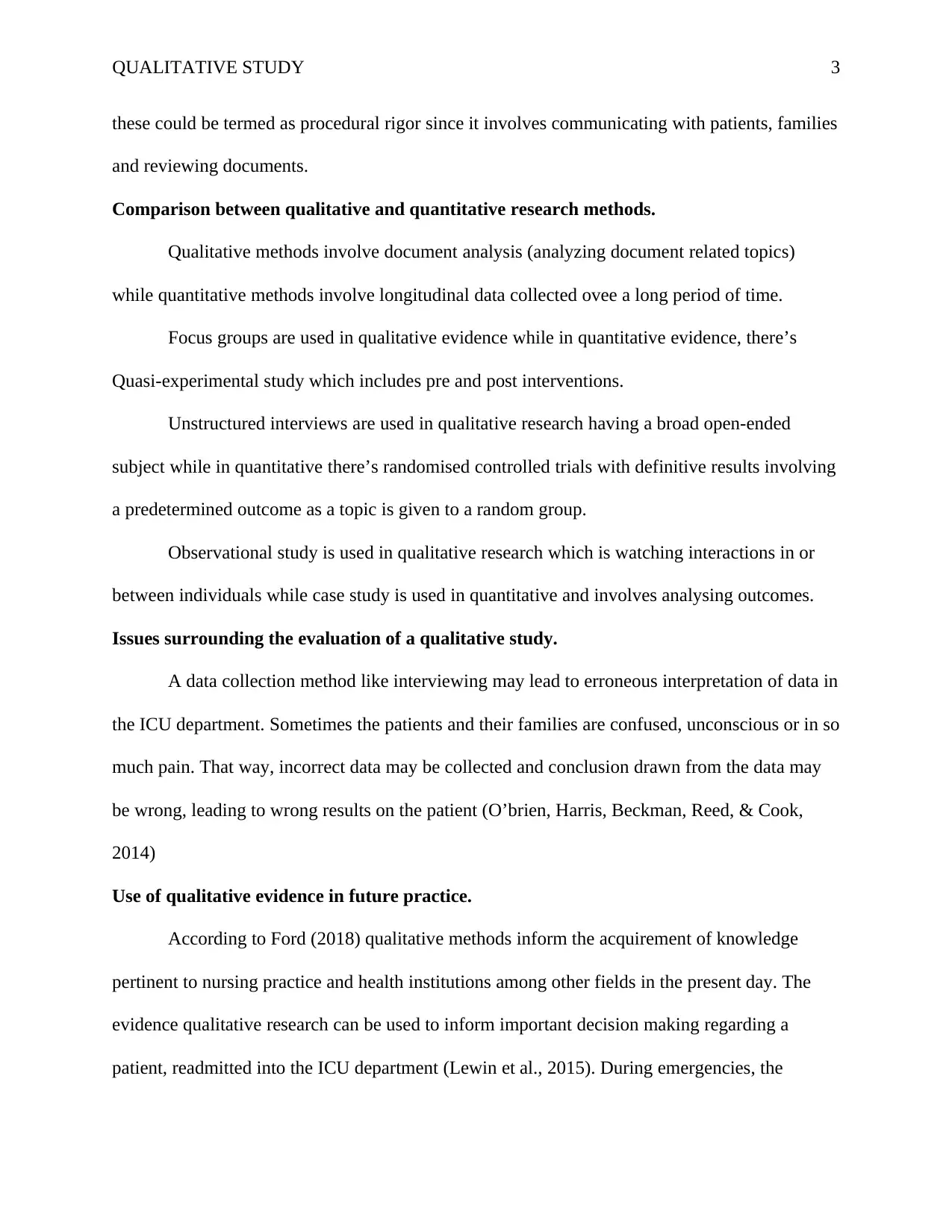
QUALITATIVE STUDY 3
these could be termed as procedural rigor since it involves communicating with patients, families
and reviewing documents.
Comparison between qualitative and quantitative research methods.
Qualitative methods involve document analysis (analyzing document related topics)
while quantitative methods involve longitudinal data collected ovee a long period of time.
Focus groups are used in qualitative evidence while in quantitative evidence, there’s
Quasi-experimental study which includes pre and post interventions.
Unstructured interviews are used in qualitative research having a broad open-ended
subject while in quantitative there’s randomised controlled trials with definitive results involving
a predetermined outcome as a topic is given to a random group.
Observational study is used in qualitative research which is watching interactions in or
between individuals while case study is used in quantitative and involves analysing outcomes.
Issues surrounding the evaluation of a qualitative study.
A data collection method like interviewing may lead to erroneous interpretation of data in
the ICU department. Sometimes the patients and their families are confused, unconscious or in so
much pain. That way, incorrect data may be collected and conclusion drawn from the data may
be wrong, leading to wrong results on the patient (O’brien, Harris, Beckman, Reed, & Cook,
2014)
Use of qualitative evidence in future practice.
According to Ford (2018) qualitative methods inform the acquirement of knowledge
pertinent to nursing practice and health institutions among other fields in the present day. The
evidence qualitative research can be used to inform important decision making regarding a
patient, readmitted into the ICU department (Lewin et al., 2015). During emergencies, the
these could be termed as procedural rigor since it involves communicating with patients, families
and reviewing documents.
Comparison between qualitative and quantitative research methods.
Qualitative methods involve document analysis (analyzing document related topics)
while quantitative methods involve longitudinal data collected ovee a long period of time.
Focus groups are used in qualitative evidence while in quantitative evidence, there’s
Quasi-experimental study which includes pre and post interventions.
Unstructured interviews are used in qualitative research having a broad open-ended
subject while in quantitative there’s randomised controlled trials with definitive results involving
a predetermined outcome as a topic is given to a random group.
Observational study is used in qualitative research which is watching interactions in or
between individuals while case study is used in quantitative and involves analysing outcomes.
Issues surrounding the evaluation of a qualitative study.
A data collection method like interviewing may lead to erroneous interpretation of data in
the ICU department. Sometimes the patients and their families are confused, unconscious or in so
much pain. That way, incorrect data may be collected and conclusion drawn from the data may
be wrong, leading to wrong results on the patient (O’brien, Harris, Beckman, Reed, & Cook,
2014)
Use of qualitative evidence in future practice.
According to Ford (2018) qualitative methods inform the acquirement of knowledge
pertinent to nursing practice and health institutions among other fields in the present day. The
evidence qualitative research can be used to inform important decision making regarding a
patient, readmitted into the ICU department (Lewin et al., 2015). During emergencies, the
⊘ This is a preview!⊘
Do you want full access?
Subscribe today to unlock all pages.

Trusted by 1+ million students worldwide
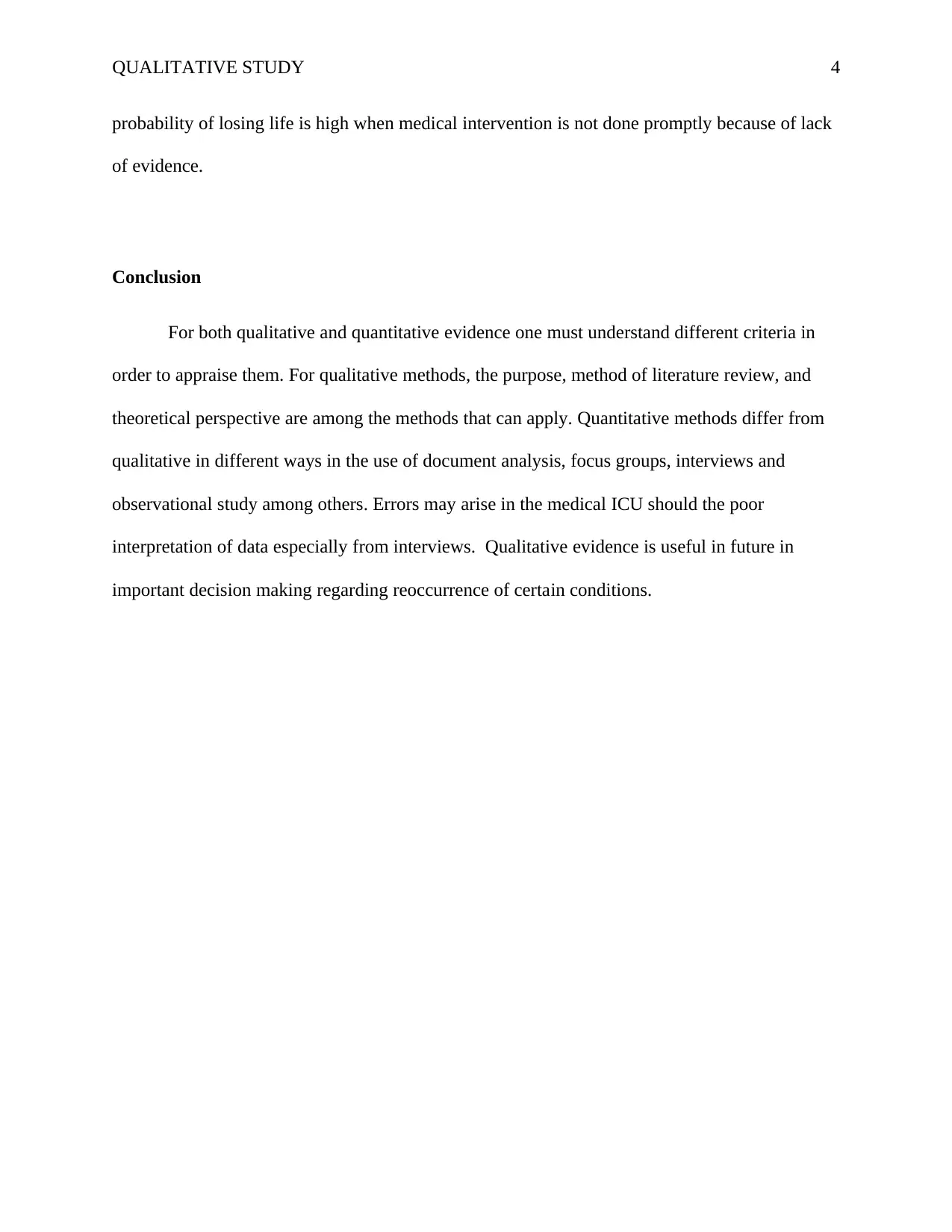
QUALITATIVE STUDY 4
probability of losing life is high when medical intervention is not done promptly because of lack
of evidence.
Conclusion
For both qualitative and quantitative evidence one must understand different criteria in
order to appraise them. For qualitative methods, the purpose, method of literature review, and
theoretical perspective are among the methods that can apply. Quantitative methods differ from
qualitative in different ways in the use of document analysis, focus groups, interviews and
observational study among others. Errors may arise in the medical ICU should the poor
interpretation of data especially from interviews. Qualitative evidence is useful in future in
important decision making regarding reoccurrence of certain conditions.
probability of losing life is high when medical intervention is not done promptly because of lack
of evidence.
Conclusion
For both qualitative and quantitative evidence one must understand different criteria in
order to appraise them. For qualitative methods, the purpose, method of literature review, and
theoretical perspective are among the methods that can apply. Quantitative methods differ from
qualitative in different ways in the use of document analysis, focus groups, interviews and
observational study among others. Errors may arise in the medical ICU should the poor
interpretation of data especially from interviews. Qualitative evidence is useful in future in
important decision making regarding reoccurrence of certain conditions.
Paraphrase This Document
Need a fresh take? Get an instant paraphrase of this document with our AI Paraphraser
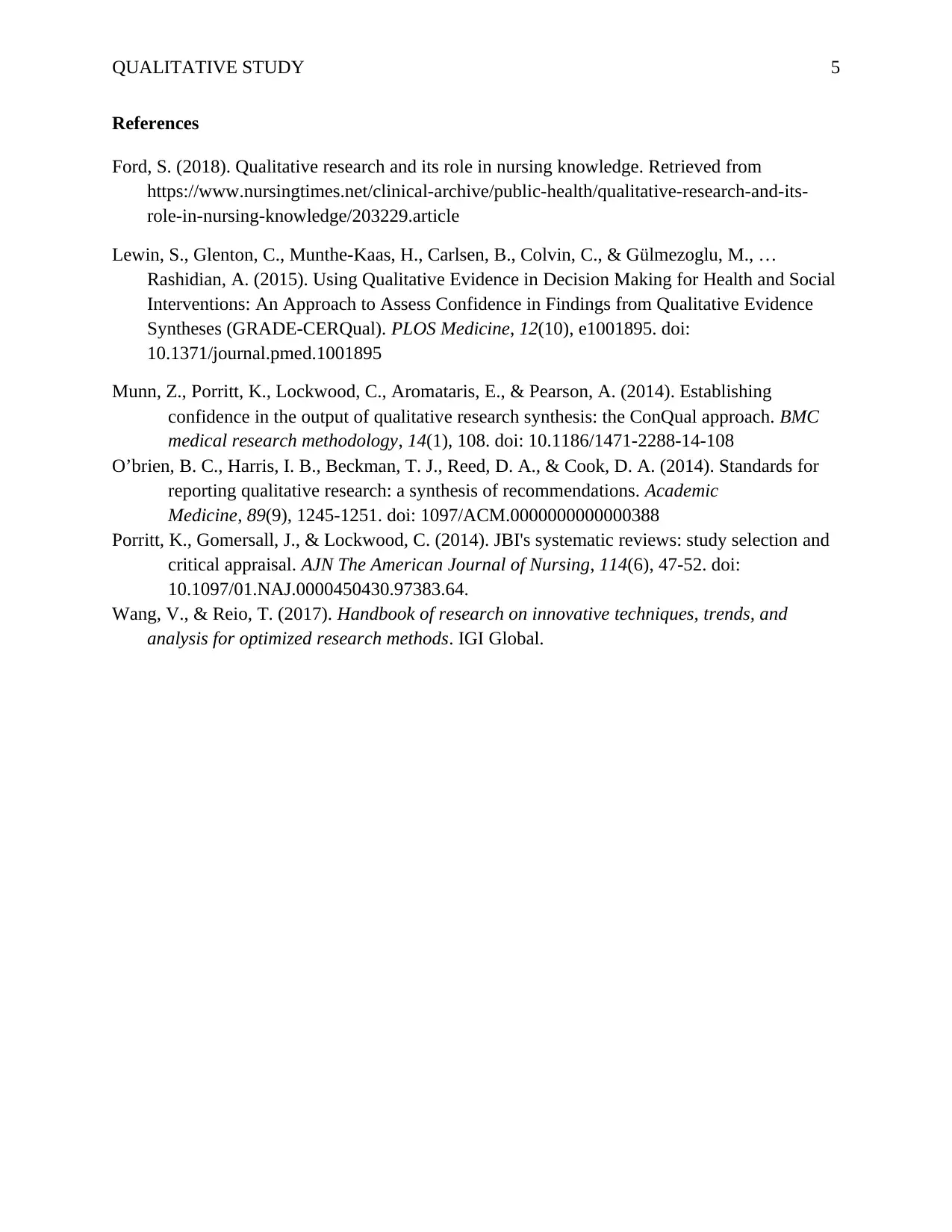
QUALITATIVE STUDY 5
References
Ford, S. (2018). Qualitative research and its role in nursing knowledge. Retrieved from
https://www.nursingtimes.net/clinical-archive/public-health/qualitative-research-and-its-
role-in-nursing-knowledge/203229.article
Lewin, S., Glenton, C., Munthe-Kaas, H., Carlsen, B., Colvin, C., & Gülmezoglu, M., …
Rashidian, A. (2015). Using Qualitative Evidence in Decision Making for Health and Social
Interventions: An Approach to Assess Confidence in Findings from Qualitative Evidence
Syntheses (GRADE-CERQual). PLOS Medicine, 12(10), e1001895. doi:
10.1371/journal.pmed.1001895
Munn, Z., Porritt, K., Lockwood, C., Aromataris, E., & Pearson, A. (2014). Establishing
confidence in the output of qualitative research synthesis: the ConQual approach. BMC
medical research methodology, 14(1), 108. doi: 10.1186/1471-2288-14-108
O’brien, B. C., Harris, I. B., Beckman, T. J., Reed, D. A., & Cook, D. A. (2014). Standards for
reporting qualitative research: a synthesis of recommendations. Academic
Medicine, 89(9), 1245-1251. doi: 1097/ACM.0000000000000388
Porritt, K., Gomersall, J., & Lockwood, C. (2014). JBI's systematic reviews: study selection and
critical appraisal. AJN The American Journal of Nursing, 114(6), 47-52. doi:
10.1097/01.NAJ.0000450430.97383.64.
Wang, V., & Reio, T. (2017). Handbook of research on innovative techniques, trends, and
analysis for optimized research methods. IGI Global.
References
Ford, S. (2018). Qualitative research and its role in nursing knowledge. Retrieved from
https://www.nursingtimes.net/clinical-archive/public-health/qualitative-research-and-its-
role-in-nursing-knowledge/203229.article
Lewin, S., Glenton, C., Munthe-Kaas, H., Carlsen, B., Colvin, C., & Gülmezoglu, M., …
Rashidian, A. (2015). Using Qualitative Evidence in Decision Making for Health and Social
Interventions: An Approach to Assess Confidence in Findings from Qualitative Evidence
Syntheses (GRADE-CERQual). PLOS Medicine, 12(10), e1001895. doi:
10.1371/journal.pmed.1001895
Munn, Z., Porritt, K., Lockwood, C., Aromataris, E., & Pearson, A. (2014). Establishing
confidence in the output of qualitative research synthesis: the ConQual approach. BMC
medical research methodology, 14(1), 108. doi: 10.1186/1471-2288-14-108
O’brien, B. C., Harris, I. B., Beckman, T. J., Reed, D. A., & Cook, D. A. (2014). Standards for
reporting qualitative research: a synthesis of recommendations. Academic
Medicine, 89(9), 1245-1251. doi: 1097/ACM.0000000000000388
Porritt, K., Gomersall, J., & Lockwood, C. (2014). JBI's systematic reviews: study selection and
critical appraisal. AJN The American Journal of Nursing, 114(6), 47-52. doi:
10.1097/01.NAJ.0000450430.97383.64.
Wang, V., & Reio, T. (2017). Handbook of research on innovative techniques, trends, and
analysis for optimized research methods. IGI Global.
1 out of 5
Related Documents
Your All-in-One AI-Powered Toolkit for Academic Success.
+13062052269
info@desklib.com
Available 24*7 on WhatsApp / Email
![[object Object]](/_next/static/media/star-bottom.7253800d.svg)
Unlock your academic potential
Copyright © 2020–2025 A2Z Services. All Rights Reserved. Developed and managed by ZUCOL.





